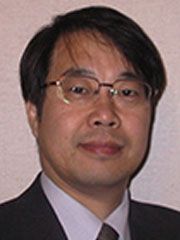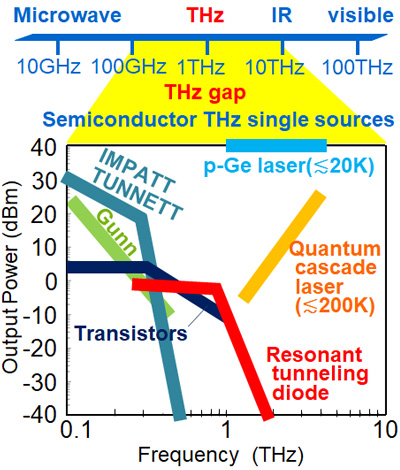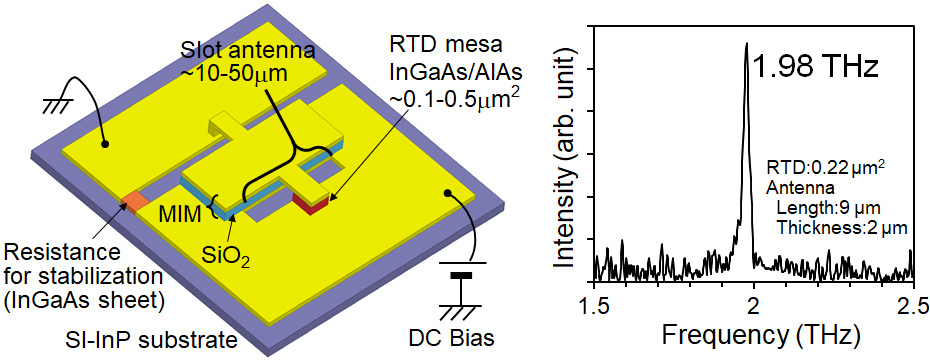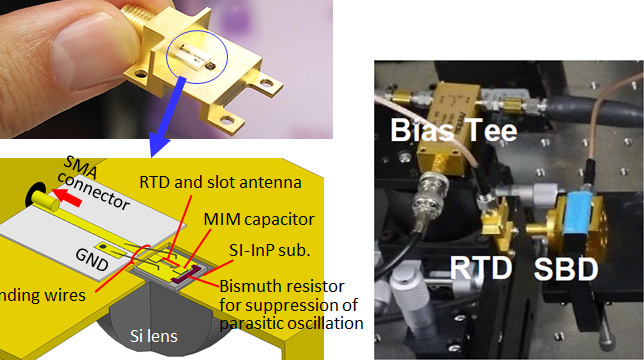Research Results
Semiconductor with nanostructure
Developing terahertz light sourcesFY2019

- Masahiro Asada(Professor, Tokyo Institute of Technology, Institute of Innovative Research, Laboratory for Future Interdisciplinary Research of Science and Technology)
- Industry-Academia Collaborative R&D Programs
- Terahertz–wave: Towards Innovative Development of Terahertz-wave Technologies and Applications
“Study of room-temperature, ultra-compact, and high-efficiency terahertz oscillators using resonant tunneling diodes” Research Director (2011-2015) - Industry-Academia Collaborative R&D Programs
- Terahertz—wave: Towards Innovative Development of Terahertz-wave Technologies and Applications
“Uncooled, highly sensitive, high-speed terahertz bolometers using MEMS resonators” Researcher(2017-2019) - ACCEL
- “Terahertz Optical Science and Technology in Semiconductors” Lead Joint Researcher(2017-2021)
Challenge to overcome the terahertz gap
The frequency around 1 THz between radio waves and light is called the terahertz band (or submillimeter waveband, far infrared), and has yet to be developed. Light sources and detectors that generate terahertz waves have not been sufficiently developed for semiconductor devices. Among researchers, this is called the terahertz gap.
In recent years, it was discovered that light sources in this frequency band can be applied to a wide range of areas such as ultra-high-speed communication, information processing, imaging, spectroscopic analysis, and measurements. Development of light sources in the terahertz frequency band is one of the key issues in the industry.
JST is implementing “Industry-Academia Collaborative R&D Programs” to promote basic research by universities to contribute toward solutions for technological problems that are shared by the industry. Within these programs, professor Masahiro Asada has achieved great success in the development of light sources in the terahertz frequency band. Using a resonant tunneling diode, which is a semiconductor device, he succeeded in emitting a 1.98 THz wave.

There is no satisfactory light source near the frequency of 1 THz, which creating a valley referred to as the terahertz gap. Currently, only the resonant tunneling diode can generate a frequency over 1 THz at room temperature in single oscillators, and this is anticipated to fill the terahertz gap.
Successful terahertz oscillation at room temperature with resonant tunneling diode
To realize high-performance light sources and detectors in the terahertz band, a semiconductor with an extremely fine structure in the nanometer order needs to be designed first. This will notably shorten the electron transit time and bring out new electronic properties due to the nanostructure.
Professor Asada et al. have pursued new phenomena aimed at the semiconductor nanostructure in the terahertz wavelength, and have conducted studies aimed at the actualization of high-performance terahertz oscillation/detection devices based on nanostructure. They were the first to succeed in terahertz oscillation at room temperature using the resonant tunneling diode, which is a nanostructure semiconductor device. However, since the output is still small, research aimed at higher outputs and oscillation at a higher frequency continues.
In addition, professor Asada et al. are working toward new terahertz devices such as a terahertz detection device and an integrated circuit. If terahertz wavelengths can be used, ultra-high-speed wireless communication of dozens to hundreds Gbps should become possible. They are working on a terahertz modulation device based on a new principle and an integrated device aimed at such wireless communication.

The first terahertz fundamental wave oscillation at room temperature by an electronic device via the use of a resonant tunneling diode. The figure on the left shows the device structure, while the figure on the right shows the oscillation spectrum.
Many achievements including high frequency, high power and wireless transmission
Professor Asada et al. have obtained many results through the development of a terahertz light source. First, they succeeded in realizing a higher frequency. They designed and fabricated a compact terahertz oscillator that integrates a micro slot antenna (a type of wireless communication antenna) and a resonant tunneling diode. This reduced the delay of electron transition in the resonant tunneling diode as well as the antenna loss, leading to room temperature oscillation at the highest frequency for semiconductor electronic devices: 1.98 THz. They also realized a higher output by optimizing the antenna structure, and obtained the highest output as a room temperature semiconductor oscillator in this frequency band (typically 0.73 mW at 1 THz).
They also developed an oscillator that does not require a hemispherical silicon lens. The hemispherical silicon lens used in the conventional method has high directivity, but may be large size, require adjustment of the optical axis, have surface loss, etc. In contrast, they proposed and fabricated an oscillator integrated with an antenna which does not require mounting of a silicon lens, and obtained a prospect of high directivity and high output.
They also successfully realized a frequency variable function. By integrating a varactor diode, a type of diode in which the capacity can be changed, in a resonant tunneling diode oscillator, they were able to create an oscillator in which electric frequency change was possible. This oscillator can generate a frequency of 0.78-0.9 THz as a single device, and 0.58-0.9 THz in an integrated multi-element array. This device could be applied to measure absorption spectra of organic materials. In addition, the integrated multi-element array allows for a variable frequency range of 1 THz or more, and a micro-integrated chip for spectroscopic analysis.
They designed a structure for a resonant tunneling diode that allows for high-speed direct modulation of the output, and achieved high-speed modulation up to 30 GHz via bias modulation. This property is useful for various measurements as well as high-speed communication, and they were successful in 56 Gbps wireless transmission by using frequency multiplexing or polarization multiplexing as an application.

The resonant tunneling diode transmission module built for communication (left). The image on the right is a data transmission system that uses the resonant tunneling diode and a Schottky-barrier diode.
Development of a key device in the field of terahertz applications
Characteristics of the resonant tunneling diode are that it is small and can be operated at room temperature. The terahertz wave is characterized by the band in which the permeability of the substance and the presence of the fingerprint spectrum for substance identification are compatible. In social implementation, a wide range of application is anticipated for the resonant tunneling diode technology associated with terahertz waves, such as security checks at airports, and so on.
Professor Asada et al. continue to work on ultra-compact and high-efficiency light sources, which would be the key devices in various applications of terahertz waves. In the future, through optimization of the resonant tunneling diode and antenna structure, they plan to actualize oscillation beyond a frequency of 2 THz and output of 1 mW, and an ultra-small and high-directivity oscillator without a silicon lens. They hope to contribute to the terahertz application field through device with extended frequency variable range, design of the structure for spectroscopic analysis chips, high-speed direct modulation in high frequency (100 GHz), and application of high-performance oscillators.
